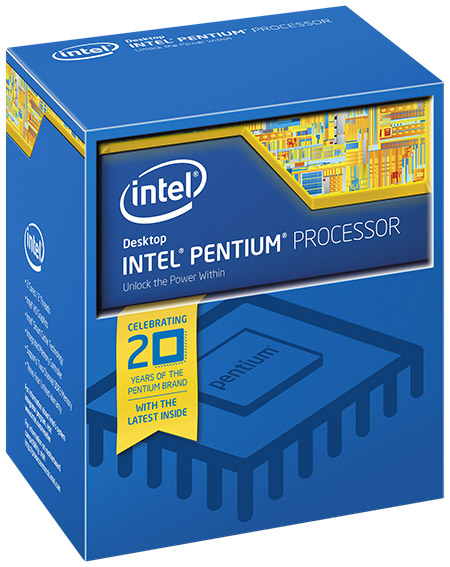Intel Pentium G3258 CPU Review: Haswell, Unlocked, For $75
It's a momentous occasion. Intel now offers an affordable dual-core Pentium with an unlocked multiplier based on its Haswell architecture. How well does it overclock? Can it beat AMD's potent little Athlon X4 750K? We run both through our benchmark suite.
An Enthusiast-Oriented Pentium CPU?
Up until now, every debate we’ve moderated between enthusiasts looking for CPUs on a budget involved an overclockable AMD processor and one of Intel’s multiplier-locked (but more efficient) models. Typically, they’re Core i3s, though if it's important to duck in under $100, you're looking at a Pentium, tops.
Intel’s stiff upper lip benefits AMD greatly. Despite higher power consumption and lower performance in a number of workloads, continued support of the enthusiast community earns AMD plenty of cachet. Meanwhile, if you want to overclock an Intel processor, your cheapest option is the $230 Core i5-3570K.
For years now, I’ve told the powers that be inside Intel they need an unlocked CPU for the folks who grew up tuning Pentiums and Celeron 300As. Surely, such an offering would make our value comparisons much more interesting.
I was more than just a little excited, then, when I learned that Intel did, in fact, plan to introduce a low-cost, multiplier-unlocked processor for enthusiasts to tool around with. And I have to imagine AMD was mortified.
The Pentium G3258: An Enthusiast Wolf In Sheep’s Clothing
Claiming to celebrate the 20th anniversary of its Pentium brand (which was technically last year), Intel is rolling out a Pentium G3258 based on its Haswell architecture. Operating at a fixed 3.2 GHz, the G3258 falls right into the middle of Intel’s current desktop Pentium family that ranges from 3.0 to 3.4 GHz. None of the Pentiums support Turbo Boost technology, none of them offer Hyper-Threading support, and all of them, including the G3258, sport two physical execution cores.
Of course, each core is complemented by 256 KB of L2 cache. There’s also a 3 MB shared L3 cache between them. Intel integrates its HD Graphics block with 10 execution units, specifying the engine to run between 350 and 1100 MHz—same as the other Pentium models. And like the rest of the family, officially, Pentium G3258 has a 53 W TDP.
If you didn’t know any better, the 20th anniversary Pentium blends right in with its stable mates. But it boasts that unlocked multiplier, which means unencumbered overclocking using the only practical knob available for tuning Intel processors. We just saw the Core i7-4790K hit 4.7 GHz in single-threaded workloads (Core i7-4790K Review: Devil's Canyon Tantalizes Enthusiasts). In theory, that should create quite a bit of headroom for a 3.2 GHz CPU to scale up. Then again, it’s just as possible these dual-core dies aren’t flexible. There is no precedent for this; we’re literally looking at Intel’s first unlocked Haswell-based chip with two cores.
Get Tom's Hardware's best news and in-depth reviews, straight to your inbox.
Quick Sync technology is also enabled, accelerating H.264, VC-1, and MPEG-2 decoding, along with H.264 encode in properly-optimized applications. This might seem like a relatively minor addition to the Pentium family. But take a look at this page of my Core i7-4770K review. If you watch a lot of multimedia content, capture video, or transcode from one format into another for your mobile devices, Intel’s application of fixed-function resources is quickly going to become a good friend.
Current page: An Enthusiast-Oriented Pentium CPU?
Next Page Overclocking Pentium G3258 And Athlon X4 750K-
Heironious Article title says its $75, the picture used says its $3 more than the i3. 75 and it's a deal otherwise no point in paying 3 bucks more for it rather than the i3.Reply -
envy14tpe It's always great seeing the full potential of technology but I'd rather see the Pentium on a mobo somebody would really buy and see how overclocking on a budget would be...more realistic.Reply -
silverblue AMD really needs a new model featuring Steamroller cores and a disabled GPU, say, a 770K. It wouldn't change the gaming scores all that much, but various benchmarks would definitely improve. As it is, the G3258 is a nice processor, but it won't go for that $75 to begin with.Reply -
Smallfilou What if "the fool" who bought that Pentium G and Z97 did so expecting to swap the processor in one year or two for a broadwell, once he got the cash? That would make him a very wise fool indeed... I'd say!Reply
Because of course buying a pentium G and fitting it with a 150USD board and 50USD cooler does not make sens by itself ,but you have a 100% future-compatible system that can be upgraded very very easily... -
knowom Could get a Q9550 for that price on Ebay nice try Intel, but that would kick the crap out of that weak Pentium it's reasonably on par with the i5. Way too damn expensive for what it is in reality.Reply -
BoredErica Hyperthreading is typically considered to be bad for Chess. It increases inefficiencies in search and although you get a larger kilonodes per second which looks nice as a benchmark score, you are actually lowering the strength of the engine. So when I look at Fritz benchmarks on PC sites I take them with a grain of salt.Reply -
lunyone I'd probably look at something like this for this kind of CPU:Reply
PCPartPicker part list / Price breakdown by merchant
CPU: Intel Pentium G3258 3.2GHz Dual-Core Processor ($74.99 @ Newegg)
CPU Cooler: Cooler Master Hyper 212 EVO 82.9 CFM Sleeve Bearing CPU Cooler ($30.99 @ Amazon)
Motherboard: ASRock Z87 Pro3 ATX LGA1150 Motherboard ($90.00 @ Newegg)
Memory: G.Skill Ares Series 8GB (2 x 4GB) DDR3-1600 Memory ($75.99 @ Newegg)
Storage: Seagate Barracuda 1TB 3.5" 7200RPM Internal Hard Drive ($52.92 @ Amazon)
Video Card: XFX Radeon R9 280 3GB Double Dissipation Video Card ($209.99 @ Newegg)
Case: Corsair 200R ATX Mid Tower Case ($49.99 @ Newegg)
Power Supply: XFX 550W 80+ Bronze Certified ATX Power Supply ($44.99 @ NCIX US)
Total: $629.86
Prices include shipping, taxes, and discounts when availableGenerated by PCPartPicker 2014-06-17 04:48 EDT-0400 -
Smallfilou Reply13521069 said:Could get a Q9550 for that price on Ebay nice try Intel, but that would kick the crap out of that weak Pentium it's reasonably on par with the i5. Way too damn expensive for what it is in reality.
No, sorry. That is not true. Check this article:
http://www.tomshardware.com/reviews/ivy-bridge-wolfdale-yorkfield-comparison,3487-10.html
You should overclock your Q9550 to get performance that barely comes close to an ivy-bridge I3 on games and lightly threaded workloads (and it gets stomped by any i5 on any workload)... I personally have an OC'd QX9650 and am not even close. I believe if I change to that Pentium G, and overclock it as well, that would still be an upgrade... -
Memnarchon Reply13520870 said:Having looked, the fool would build a cheap pc with that chip and a z97 board, and the wise man would use the i3 and an h81 board. Similar priced systems..
Yeah that would be better unless Intel decides to let o/c on Pentium with other chipsets like H97.
Leaked BIOS Enables Pentium Anniversary Edition OC on Some MSI H97 Boards
MSI H97 PC MATE ATX LGA1150 Motherboard $88.99
So if this happens and intel decide to let even lower mobo chipsets to do o/c only for pentiums it would be nice to pair $60 mobo, $75 CPU and a $25-30 CM 212 EVO or plus, to a total of ~$160 for a o/c ready system.


